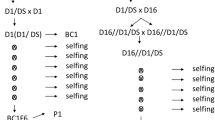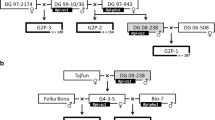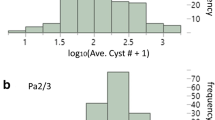Summary
Dihaploids were produced from tetraploids which had resistance to foliage late blight (P. infestans) and had a range of levels of resistance to white potato cyst nematode (PCN) (G. pallida). Twelve of 33 dihaploids tested had useful levels of both resistances, 11 were resistant to blight alone and seven to PCN alone. There were no significant correlations between the resistances of the parents and the mean resistance of their dihaploids, for either character. There was also no correlation between levels of resistance to blight and to PCN. There were significant differences in mean levels of resistance to blight and to PCN between the tetraploid progenies of two dihaploids which possessed combined resistance.
Similar content being viewed by others
References
De,Maine, M. J., 1978. Field resistance to late blight and potato root eelworm in group Tuberosum dihaploids.Euphytica 27: 305–315.
De,Maine, M. J., 1982. An evaluation of the use of dihaploids and unreduced gametes in breeding for quantitative resistance to potato pathogens.Journal of agricultural Science, Cambridge 99: 79–83.
De,Maine, M. J. & H. E. Stewart, 1988. An assessment of the fertiliser response and other characters of three dihaploid potatoes and the characteristics of their tetraploid progenies.Euphytica (in the press).
De,Maine, M. J., L. A. Farrer & M. S. Phillips, 1986. Breeding for quantitative resistance to potato cyst nematode (Globodera pallida) using dihaploids and unreduced gametes.Euphytica 35: 1001–1006.
Jongedijk, E., 1985. The pattern of megasporogenesis in diploidSolanum species hybrids; its relevance in potato breeding.Euphytica 34: 599–611.
Malcolmson, J. F., 1976. Assessment of field resistance to blight. (Phytophthora infestans) in potatoes.Transactions of the British Mycological Society 67: 321–325.
Phillips, M. S., J. M. S. Forrest & L. A. Wilson, 1980. Screening for resistance to potato cyst nematode using closed containers.Annals of applied Biology 96: 317–322.
Snedecor, G. W. & W. G. Cochran, 1980, Statistical methods. Iowa State Press, Ames, Iowa, USA.
Stewart, H. E., P. H. Flavelle, D. C. McCalmont & R. L. Wastie, 1983. Correlation between glasshouse and field tests for resistance to foliage blight caused byPhytophthora infestans.Potato Research 26: 41–48.
Author information
Authors and Affiliations
Rights and permissions
About this article
Cite this article
De Maine, M.J., Stewart, H.E. & Phillips, M.S. The production of dihaploids and tetraploids with combined quantitative resistance to potato cyst nematode (Globodera pallida) and foliage blight (Phytophthora infestans). Potato Res 32, 425–430 (1989). https://doi.org/10.1007/BF02358497
Accepted:
Issue Date:
DOI: https://doi.org/10.1007/BF02358497




